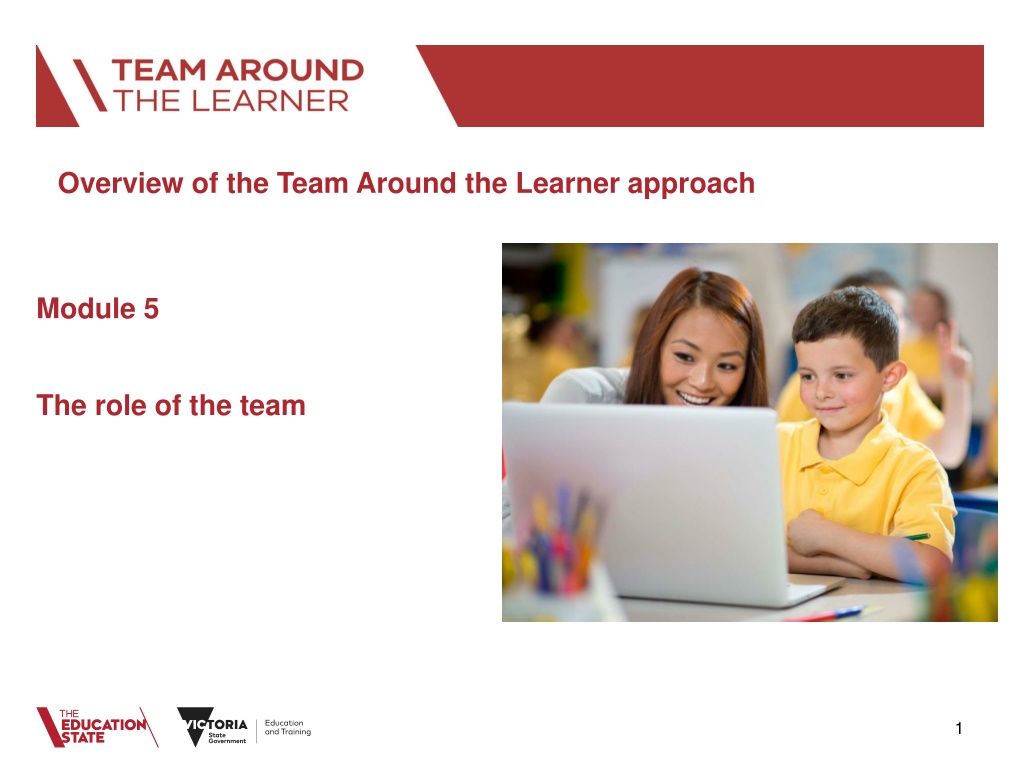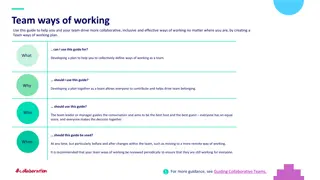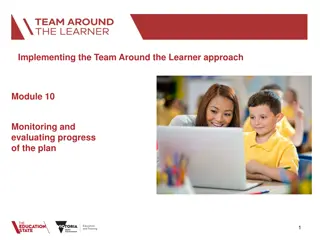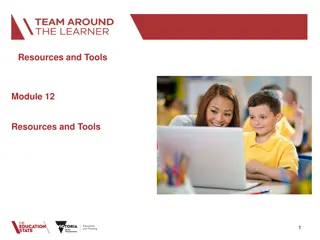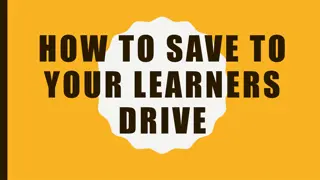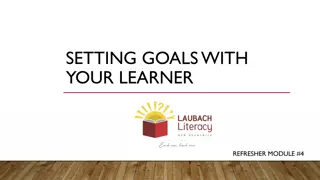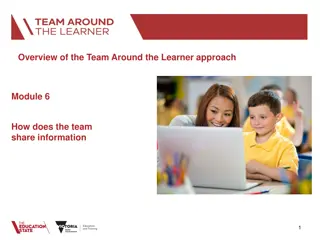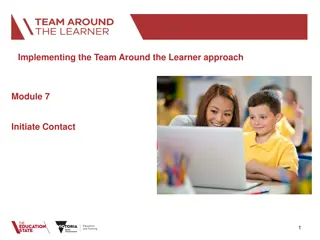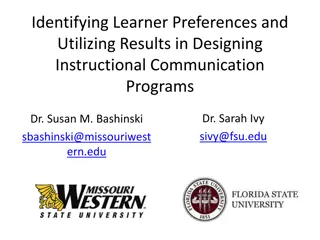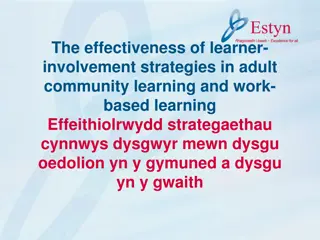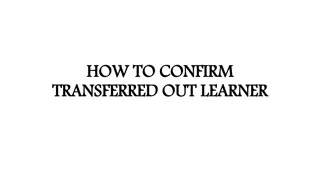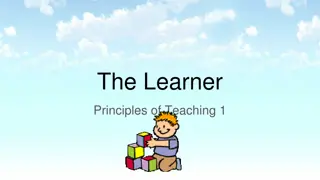Understanding the Role of the Team Around the Learner Approach
This module focuses on clarifying the role and expectations of the support team for learners, emphasizing collaborative teamwork for positive educational outcomes. It highlights the importance of teamwork in meeting learner needs and sustaining education, outlining responsibilities and key phases in the Team Around the Learner approach.
Download Presentation

Please find below an Image/Link to download the presentation.
The content on the website is provided AS IS for your information and personal use only. It may not be sold, licensed, or shared on other websites without obtaining consent from the author. Download presentation by click this link. If you encounter any issues during the download, it is possible that the publisher has removed the file from their server.
E N D
Presentation Transcript
Overview of the Team Around the Learner approach Module 5 The role of the team 1
Module 5: The role of the team Overview This section focuses on clarifying and describing the role and expectations of those who make up the support team for the learner. As outlined in Module 2, teams are made up of people who are connected to the learner through natural, community and formal support relationships. Examples of team members include the learner and family, education professionals, external community agencies, other government departments, relatives. It is important that the team are able to put aside individual agendas to work collaboratively for the best outcomes of the learner. Focus Completion of this module will support your understanding of: 5 How to work collaboratively as part of a learner s support team Working collaboratively as a part of the learners support team Understanding the role of feedback Providing feedback Receiving feedback 2
Working collaboratively as a part of the learners support team Teamwork is the cornerstone of the Team Around the Learner approach. Teamwork is the reason why this approach works in meeting the needs of the learner and sustaining them in education. The team is required to effectively collaborate and connect with each other with the primary focus on the learner s positive educational outcomes. Working collaboratively as a team requires the team members to: Be able to recognise the need for a co-ordinated service and support approach Work to freely articulate their knowledge and views regarding the learner (fully participate) Be able to listen respectfully to all views of team members (respect the opinion of others) Uphold the Team Around the Learner key principles Work with others to develop a coordinated plan Support the Lead Professional where required Commit to meetings and actions as determined by the group Share ideas and collaborate with other team members Remain accountable for their actions Work with families because of the learner s specific needs and to help the learner engage in education Be sensitive to the context of the family as it relates to the learner s ability to engage in education 3
Working collaboratively as a part of the learners support team The following pages outline the responsibilities of the key roles in each phase of the Team Around the Learner approach. Members of the support team must engage in all phases of the Team Around the Learner approach. The following table (from Module 2) highlights some activities that a team member might engage in throughout the approach. Phases of Team Around the Learner Initiate Contact Analyse Needs Plan & Coordinate Support Monitor & Evaluate Plan Transition Be open to participating in the Team Around the Learner process as required Participate in team activities as required Assist in conducting needs analysis where able and required Contribute to the development of a Plan Conduct roles and responsibilities as outlined in the Plan Support the Lead Professional Work as part of a team, cooperating and communicating with others Uphold the principles of the Team Around the Learner process Attend meetings Uphold roles and responsibilities Communicate the progress of actions and strategies with the Lead Professional and other Team members in a timely manner Continue to implement the Plan Attend and participate in team meetings and activities Participate in the development of the Transition Plan Celebrate successes Continue to support the learner and family as required 4
Understanding the role of feedback Feedback is the process of passing information from one person to another about the effectiveness of the interventions that have been put in place. It involves open communication between all members of the team. It is essential that the communication is not seen as one way. Feedback is a powerful tool that can be used to: encourage and confirm that the team is on track provide insight as to how the learner, family and team members are working and feeling increase motivation and team satisfaction increase feelings of involvement assist with measuring outcomes of actions and strategies help identify improvements to increase the effectiveness of strategies, actions and teamwork 5
Maximising the impact of feedback For feedback to be effective, there are a number of forms that it should take. During the Team Around the Learner approach, the Lead Professional will provide feedback to the learner, family and team members to inform them about their actions, strategies and behaviours. Team members can also provide feedback to improve the team's ability in achieving learner goals. Goal Driven Focuses on a behaviour not an individual The number one rule for providing feedback is: Try to make it a positive and constructive process and experience Is two way Effective Feedback Some tips for delivery include: Prepare your comments Be specific Focus on feedback that looks for improvements Use "I" statements to avoid labelling the person Provide specific suggestions Follow-up Is Is specific objective Is timely and specific 6
Providing feedback Feedback is given to provide insight into a particular task, action and/or behaviours that was done well or that need improvement. This can reinforce a behaviour or help people to determine an alternative way of working Positive Feedback Feedback for Improvement There are two main types of feedback that people most often use: Positive Feedback: affirming comments about the impact of behaviour or actions. These are things that went well and should be repeated. "You did a great job helping the learner complete that action" "When you use simpler language, it is a lot easier to understand what you are saying" Feedback for Improvement: comments that outline less effective outcomes of a task or action; or the impact of behaviours. Alternative strategies or actions are suggested to improve things for the future. 7
Providing feedback Depending on the situation, providing feedback can be challenging. Below are some commonly faced stumbling blocks and tips on how to overcome them. Stumbling Blocks Tips Always link constructive feedback to a situation Keep feedback specific and actionable Use examples General comments Keep comments relevant to the task at hand Keep comments focused on things that can be changed Personal comments Start with strengths Focus on improvements A strong focus on negativity Use language that starts with "I " e.g. "I think that " or "I felt that " rather than "You have " Accusation Keep feedback targeted to avoid overloading the team with information Feedback overload 8
Providing feedback Depending on the content of the discussion, feedback can be delivered informally or formally. Providing feedback can be informal or formal. The method will depend on what is being discussed and in what context. Examples of informal and formal feedback during the Team Around the Learner approach are provided below: 9
Providing Feedback The tips on this page will support you in providing feedback for improvement. It is probably safe to say that it is the delivery of feedback for improvement that can elicit some undesirable reactions from the recipient. Some people have a very difficult time dealing with feedback for improvement. The recipient may: Question your comments Become upset or emotional Make a complaint In these circumstances, it is important to immediately address any concerns the recipient has. This can be done by: Reassuring them of the things that they are doing well Explaining that feedback is a normal part of the Team Around the Learner process to support the team in delivering on the learner's needs Providing further clarification regarding your comments Giving the individual time to calm down Offering support Focusing on the improvement rather than the issue 10
Receiving Feedback Feedback can be collected during: Meetings with the learner, family, and team members Phone calls with the learner, family, and team members Forms Surveys or questionnaires All team members should recognise that feedback can also be: An initial reaction during or following an action, activity or idea Verbal conversations Observations (body language and facial expressions) Surveys and forms can be used for recording feedback. These should be clear, easy to understand and appropriate for the audience. Open Surveys & Questionnaires The structure and type of survey should be specific to its target audience Discussions You may want to ask questions like: Am I doing this correctly? Is there another way I can do this? 11
Receiving feedback It is important to practice self-reflection to continuously improve the way each team member conducts themselves. Reflective practice involves taking the time to think about different aspects of the role of team members and what can be done better. It is a form of providing feedback to yourself. Reflective practice in the context of the Team Around the Learner approach can be the most important source of personal professional development and improvement. Self reflection can be achieved by: Reflecting on your work and seeing if there are any improvements that can be made Listening to feedback from others Taking on training opportunities to continue your development Questions you can ask yourself include: How did I decide to do things this way? Who benefits from the way I do things? Can I do it better in a different way? 12
